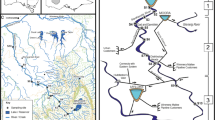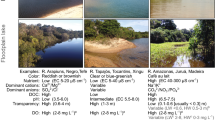Abstract
Fatty acids are integral components of periphyton and differ among algal taxa. We examined seasonal patterns in periphyton fatty acids in six minimally disturbed headwater streams in Pennsylvania’s Appalachian Mountains, USA. Environmental data and periphyton were collected across four seasons for fatty acid and algal taxa content. Non-metric multidimensional scaling ordination suggested significant seasonal differences in fatty acids; an ordination on algal composition revealed similar seasonal patterns, but with slightly weaker separation of summer and fall. Summer and fall fatty acid profiles were driven by temperature, overstory cover, and conductivity and winter profiles by measures of stream size. Ordination on algal composition suggested that summer and fall communities were driven by overstory and temperature, whereas winter communities were driven by velocity. The physiologically important fatty acid 18:3ω6 was highest in summer and fall. Winter samples had the highest 20:3ω3. Six saturated fatty acids differed among the seasons. Periphyton fatty acids profiles appeared to reflect benthic algal species composition. This suggests that periphyton fatty acid composition can be useful in characterizing basal food resources and stream water quality.



Similar content being viewed by others
References
Ahlgren, G., I. Gustafsson & M. Boberg, 1992. Fatty acid content and chemical composition of freshwater microalgae. Journal of Phycology 28: 37–50.
Akoh, C. C. & D. B. Min, 2008. Food Lipids: Chemistry, Nutrition and Biotechnology. CRC Press, Boca Raton.
Aricha, B., I. Fishov, Z. Cohen, N. Sikron, S. Pesakhov, I. Khozin-Goldberg, R. Dagan & N. Porat, 2004. Differences in membrane fluidity and fatty acid composition between phenotypic variants of Streptococcus pneumonia. Journal of Bacteriology 186: 4638–4644.
Arts, M. T., 1999. Lipids in freshwater zooplankton: selected ecological and physiological aspects. In Arts, M. T. & B. C. Wainman (eds), Lipids in Freshwater Ecosystems. Springer, New York: 71–90.
Arts, M. T., R. G. Ackman & B. J. Holub, 2001. ”Essential fatty acids” in aquatic ecosystems: a crucial link between diet and human health and evolution. Canadian Journal of Fisheries and Aquatic Sciences 58: 122–137.
Bligh, E. & W. J. Dyer, 1959. A rapid method of total lipid extraction and purification. Canadian Journal of Biochemistry and Physiology 37: 911–917.
Brett, M. T. & D. C. Muller-Navarra, 1997. The role of highly unsaturated fatty acids in aquatic foodweb processes. Freshwater Biology 38: 483–499.
Brown, L. R., J. T. May & C. T. Hunsaker, 2008. Species composition and habitat associations of benthic algal assemblages in headwater streams of the Sierra Nevada, California. Western North American Naturalist 68: 194–209.
Castell, J. D., R. O. Sinnhuber, J. H. Wales & D. J. Lee, 1972. Essential fatty acids in the diet of rainbow trout Salmo gairdneri: growth feed conversion and some gross deficiency symptoms. Journal of Lipid Nutrition 102: 77–86.
Cook, H. W. & C. R. McMaster, 2002. CHAPTER 7. Fatty acid desaturation and chain elongation in eukaryotes. In Vance, D. E. & J. E. Vance (eds.), Biochemistry of Lipids, Lipoproteins and Membranes, 4th ed. Elsevier Science B.V., New York: 181–204.
Cunnane, S. C., 2003. Problems with essential fatty acids: time for a new paradigm. Progress in Lipid Research 42: 544–568.
Fernandes Da Silva, C., E. Ballester, J. Monserrat, L. Geracitano, W. Wasielesky Jr & P. C. Abreu, 2008. Contribution of microorganisms to the biofilm nutritional quality: protein and lipid contents. Aquaculture Nutrition 14: 507–514.
Flynn, K. F., S. C. Chapra & M. W. Suplee, 2013. Modeling the lateral variation of bottom-attached algae in rivers. Ecological Modelling 267: 11–25.
Fuschino, J. R., I. A. Guschina, G. Dobson, N. D. Yan, J. L. Harwood & M. T. Arts, 2011. Rising water temperatures alter lipid dynamics and reduce N-3 essential fatty acid concentrations in Scenedesmus obliquus (Chlorophyta). Journal of Phycology 47: 763–774.
Genter, R. B. & R. M. Lehman, 2000. Metal toxicity inferred from algal population density, heterotrophic substrate use, and fatty acid profile in a small stream. Environmental Toxicology and Chemistry 19: 869–878.
Ghioni, C., A. E. A. Porter, G. W. Taylor & D. R. Tocher, 2002. Metabolism of 18:4n-3 (stearidonic acid) and 20:4n-3 in salmonid cells in culture and inhibition of the production of prostaglandin F2α (PGF2α) from 20:4n-6 (arachidonic acid). Fish Physiology and Biochemistry 27: 81–96.
Glemet, H. C., M. F. Gerrits & J. S. Ballantyne, 1997. Membrane lipids of red muscle mitochondria from land-locked and sea-run Arctic char (Salvelinus alpinus). Marine Biology 129: 673–679.
Harwood, J. L., 1998. Membrane lipids in algae. In Siegenthaler, P. A. & N. Murata (eds), Lipids in Photosynthesis: Structure, Function and Genetics. Advances in Photosynthesis and Respiration, vol. 6. Springer, Dordrecht: 15–29.
Hill, W. R. & A. W. Knight, 1987. Experimental analysis of the grazing interaction between a mayfly and stream algae. Ecology 68: 1955–1965.
Hill, W. R., B. J. Roberts, S. N. Francoeur & S. E. Fanta, 2011a. Resource synergy in stream periphyton communities. Journal of Ecology 99: 454–463.
Hill, W. R., J. Rinchard & S. Czesny, 2011b. Light, nutrients and the fatty acid composition of stream periphyton. Freshwater Biology 56: 1825–1836.
Huggins, K., J. J. Frenette & M. T. Arts, 2004. Nutritional quality of biofilms with respect to light regime in Lake Saint-Pierre (Québec, Canada). Freshwater Biology 49: 945–959.
Klurfeld, D. M., 2008. Dietary fats, eicosanoids, and the immune system. In Food Lipids: Chemistry Nutrition, and Biotechnology. CRC Press, Boca Raton: 539–549.
Kruskal, J. B., 1964. Multidimensional scaling by optimizing goodness of fit to a nonmetric hypothesis. Psychometrika 29: 1–27.
Larned, S. T., 2010. A prospectus for periphyton: recent and future ecological research. Journal of North American Benthological Society 29: 182–206.
Lear, G., A. Dopheide, P. Y. Ancion, K. Roberts, V. Washington, J. Smith & G. D. Lewis, 2012. Biofilms in freshwater: their importance for the maintenance and monitoring of freshwater health. Chapter 8. In Lear, G. & G. D. Lewis (eds), Microbial Biofilms: Current Research and Applications. Caister Academic Press, Norfolk, UK: 129–151.
Littlefield-Wyer, J. G., P. Brooks & M. Katouli, 2008. Application of biochemical fingerprinting and fatty acid methyl ester profiling to assess the effect of the pesticide Atradex on aquatic microbial communities. Environmental Pollution 153: 393–400.
Lloyd, L. E., B. E. McDonald & E. W. Crampton, 1978. Fundamentals of Nutrition, 2nd ed. W. H. Freeman, San Fransisco: 466.
Lock, M. A., R. R. Wallace, J. W. Costerton, R. M. Ventullo & S. E. Charlton, 1984. River epilithon: toward a structural-functional model. Oikos 42: 10–22.
McCune, B. & J. B. Grace, 2002. Analysis of Ecological Communities. MjM Software Design, Gleneden Beach, Oregon.
Mulholland, P. J., J. W. Elwood, A. V. Palumbo & R. J. Stevenson, 1986. Effect of stream acidification on periphyton composition, chlorophyll, and productivity. Canadian Journal of Fisheries and Aquatic Sciences 43: 1846–1858.
Napolitano, G. E., 1999. Fatty Acids as Trophic and Chemical Markers in Freshwater Ecosystems: Lipids in Freshwater Ecosystems. Springer, New York: 21–44.
Oksanen, J., R. Kindt, P. Legendre, & B. O’Hara, 2012. The vegan Package, version 2.0-5.
R Development Core Team, 2013. R: A language and environment for statistical computing. v. 2.15.2. In. R Foundation for Statistical Computing, Vienna, Austria. ISBN 3-900051-07-0.
Rhoads, A. F., T. A. Block & A. Anisko, 2004. Trees of Pennsylvania: A Complete Reference Guide. University of Pennsylvania Press, Philadelphia, PA.
Sargent, J. R., J. G. Bell, M. V. Bell, R. J. Henderson & D. R. Tocher, 1995. Requirement criteria for essential fatty acids. Journal of Applied Ichthyology 11: 183–198.
Schlechtriem, C., R. J. Henderson & D. R. Tocher, 2008. A critical assessment of different transmethylation procedures commonly employed in the fatty acid analysis of aquatic organisms. Limnology and Oceanography: Methods 6: 523–531.
Sigurgisladottir, S., S. P. Lall, C. C. Parrish & R. G. Ackman, 1992. Cholestane as a digestibility marker in the absorption of polyunsaturated fatty acid ethyl esters in Atlantic salmon. Lipids 27: 418–424.
Soininen, J., 2007. Environmental and spatial control of freshwater diatoms: a review. Diatom Research 22: 473–490.
Soininen, J. & P. Eloranta, 2004. Seasonal persistence and stability of diatom communities in rivers: are there habitat specific differences? European Journal of Phycology 39: 153–160.
Stevenson, R. J., & L. L. Bahls, 1999. Periphyton protocols: U.S. Environmental Protection Agency EPA 841-B-99-002, Chapter 6: 1–22
Stewart, K. A., S. F. Lamoureux & A. C. Forbes, 2005. Hydrological controls on the diatom assemblage of a seasonal Artic river: Boothia Peninsula, Nunavut, Canada. Hydrobiologia 544: 259–270. doi:10.1007/s10750-005-0864-3
Sushchik, N. N., M. I. Gladyshev, E. A. Ivanova & E. S. Kravchuk, 2010. Seasonal distribution and fatty acid composition of littoral microalgae in the Yenisei River. Journal Applied Phycology 22: 11–24.
Torres-Ruiz, M., J. D. Wehr & A. A. Perrone, 2007. Trophic relations in a stream food web: importance of fatty acids for macro invertebrate consumers. Journal North American Benthological Society 26: 509–522.
Torres-Ruiz, M., J. D. Wehr & A. A. Perrone, 2010. Are net-sppinning caddisflies what they eat? An investigation using controlled diets and fatty acids. Journal North American Benthological Society 29: 803–813.
van Dam, A. A., M. C. M. Beveridge, M. E. Azim & C. J. Verdegem, 2002. The potential of fish production based on periphyton. Reviews in Fish Biology and Fisheries 12: 1–31.
Volk, C. & P. Kiffney, 2012. Comparison of fatty acids and elemental nutrients in periphyton, invertebrates, and cutthroat trout (Oncorhynchus clarki) in conifer and alder streams of western Washington State. Aquatic Ecology 46: 85–99.
Wipfli, M. S., J. Hudson & J. Caouette, 1998. Influence of salmon carcasses on stream productivity: Response of biofilm and benthic macroinvertebrates in southeastern Alaska, USA. Canadian Journal of Fisheries and Aquatic Sciences 55: 1503–1511.
Acknowledgments
We thank Daniel Spooner and other members of the U.S. Geological Survey, Northern Appalachian Research Laboratory as well as Richard Mitchell of the U.S. Environmental Protection Agency, Barry Baldigo and Scott George, US Geological Survey for their insightful comments on earlier drafts of the manuscript. Comments from Zhengwen Liu and two anonymous reviewers also greatly improved the manuscript. Authors contributed equally in the work reported here. Use of trade, product or firm names does not imply endorsement by the U.S. Government.
Author information
Authors and Affiliations
Corresponding author
Additional information
Handling editor: Zhengwen Liu
Rights and permissions
About this article
Cite this article
Honeyfield, D.C., Maloney, K.O. Seasonal patterns in stream periphyton fatty acids and community benthic algal composition in six high-quality headwater streams. Hydrobiologia 744, 35–47 (2015). https://doi.org/10.1007/s10750-014-2054-7
Received:
Revised:
Accepted:
Published:
Issue Date:
DOI: https://doi.org/10.1007/s10750-014-2054-7




